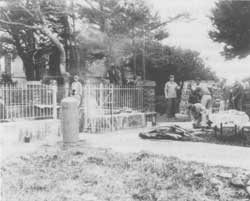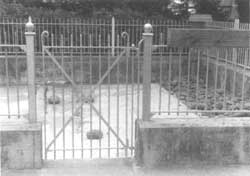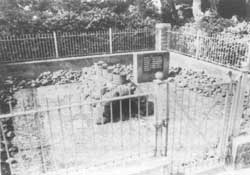|
Fort Clatsop
Administrative History |

|
CHAPTER TWO:
HISTORICAL BACKGROUND (continued)
The Salt Works Site, 1806-1978

Seaside Lions Club constructing the Salt Works replica, 1955.
(FOCL photo collection)
One thing Captains Lewis and Clark intended to achieve during their winter encampment was the production of salt from ocean water. For that purpose, they sent a group of men to the coast. The saltmakers produced a total of about four bushels of salt, which the captains hoped would last them until they reached their caches of supplies along the Missouri River. Having the salt at Fort Clatsop was a benefit nutritionally and helped flavor elk meat that was already spoiling.
On December 28, 1805, Lewis and Clark sent "Jos. Fields, Bratten, Gibson to proceed to the Ocean at Some Convenient place form a camp and commence makeing Salt with 5 of the largest Kittles, and Willard and Wiser to assist them in carrying the Kittles to the Sea Coast". [32] From December 28 until their return to Fort Clatsop on February 21, 1806, the Salt Works operated continuously. The site was established near a village containing four houses of Clatsops and Tillamooks in what is today the town of Seaside, Oregon. The men camped in tents, near the mouth of the Necanicum River and "100 paces" from the ocean. [33]
From the journals, it is evident that there were always at least three men at the saltworks site, but the personnel did shift as necessary. George Gibson, William Bratton, and Joseph Field were stationed at the site most of that two months. While no description is given of the structure built for boiling ocean water, oral testimony about the site indicates stones were placed in an oven or cairn shape with one end left open. Working through the open end, a fire was built inside the stone oven and five kettles placed on the top. This testimony is derived primarily from stories passed down through the generations by Clatsops living during the expedition's stay and who witnessed the salt making. The captains report in their journals on January 5, 1806 that the salt makers could produce from three quarts to one gallon of salt a day, which means they were boiling approximately 40 gallons of sea water a day. [34] It was labor-intensive work, keeping the fire hot enough to boil the salt water and keeping up the supply of fire wood. The journals indicate also that the salt camp was extremely short on food most of the time and at least one hunting party was specifically sent out from Fort Clatsop to hunt for the salt camp. Lack of food, the constant labor demands, and more direct exposure to the weather than experienced by the men at the fort meant that by the beginning of February the salt makers were hit hard by illness. Gibson had to be carried back to the fort he was so ill and Bratton was plagued by lower back pains long after leaving Fort Clatsop for home.
The history of the salt works site is very similar to that of Fort Clatsop. As American settlers moved into the area, the salt works was reportedly still visible and a tradition of oral testimony developed as to the location of the site. The same trip of August, 1899, that brought Olin D. Wheeler to Fort Clatsop for its identification brought Wheeler to Seaside to locate the salt works. Wheeler and his party of locals, including Silas B. Smith, went to the site on August 28, 1899, where he reported that stones from the salt works "cairn" were still visible. Smith, the grandson of Clatsop Chief Comowool, reported that it was the site that his mother had pointed out to him as the place where the expedition made salt. [35]
On June 8-9, 1900, the representatives of the Oregon Historical Society who had Fort Clatsop identified travelled to the salt works site for the same purpose. OHS took along a Clatsop Indian woman named Jennie Michel, or Tsinistum, to help identify the site. She was 86 years old at the time. In a deposition for OHS, she stated that she had often been to the site with her mother and other Clatsops who had been alive in 1806 during the expedition's stay and was told this was the spot where they made salt. [36] Her testimony was corroborated by Judge Thomas A. McBride, who had grown up on the Clatsop Plains and had been shown the site by Silas B. Smith's mother. Judge McBride's visit to the site took place after Jennie Michel's, in December 1900. Just as they had done with the site of Fort Clatsop, the historical society documented the location of the salt works site, which was then being referred to as the Salt Cairn.

Salt Works site just prior to construction of replica.
(FOCL photo collection)
After the 1900 visit, OHS had a fence installed around the ruins in cooperation with the site's owner. The site identified as the Salt Cairn was Lot 18, Block 1 of Cartwright Park, Seaside and the owner, Charlotte Moffett Cartwright, deeded the site to OHS as a gift to be held in "trust for the people of the State of Oregon for historical purposes only". [37] The deed was recorded on June 16, 1910.
By this time, Seaside had developed into a coastal resort town, a popular destination for vacationing Portlanders. In the 1920s, public interest continued in the Salt Cairn site. In 1925, the Great Northern Railway Company, whom Olin D. Wheeler had represented on his visit, along with the Spokane, Portland, and Seattle Railways, funded improvements at the site. Their goal was to provide a historical destination for railroad passengers. Landscape improvements included a sidewalk and an ornate iron fence placed on a brick foundation which enclosed the ruins.
Around the same time of Sesquicentennial celebrations and the building of the Fort Clatsop replica, the Seaside Lions Club began a replica project at the Salt Cairn. They hauled in stones and built a stone and cement cairn and placed five foundry kettles on top. Two bronze plaques described the site and its importance. Dedication ceremonies were held at the site during the Sesquicentennial celebrations of 1955.
The Seaside Lions Club maintained the site and provided policing efforts as well as they could. They sponsored clean-up projects at the site and the City of Seaside provided garbage service for one trash receptacle at the site. The volunteer efforts were limited, though, and the site was plagued by littering and occasional vandalism, with no site repairs being made. Interpretation at the site was never improved beyond the 1950s bronze markers. During the creation of Fort Clatsop National Memorial from 1956 to 1958, the saltworks site was never seriously considered for inclusion. At the time, the distance of the saltworks from the proposed memorial site was enough to discourage researching its authenticity and considering its inclusion.
During the 1960s, the Smithsonian Institution sponsored archeological excavations along the northern coast of Oregon. These excavations included the exploration of middens located in a golf course southeast of the saltworks site. These middens were believed to be the possible location of the Clatsop and Tillamook village the salt makers camped by. If those middens were the same village as mentioned in the journals, then the location of the saltworks camp would have been further south than the site owned by the historical society. No further examination of this question was undertaken. Several years later, opponents of the proposed Salt Works addition to the memorial, who felt that the authenticity of the site was questionable, used the excavations to support their position. Those who supported the addition of the site to the memorial maintained that further excavations would probably not reveal any evidence proving it to be the salt makers neighboring village or any evidence of the salt makers camp.

Salt Works replica.
(FOCL photo collection)
From 1959 until its inclusion in Fort Clatsop National Memorial, the Salt Works site remained relatively unchanged, managed by the Seaside Lion's Club. In 1968, the Oregon Historical Society offered to donate the site to the National Park Service. With this offer, a ten-year debate over the addition of the Salt Works to the memorial began.
During the settlement of Oregon in the 1800s and into the 1900s, the sites of Fort Clatsop and the Salt Works held an attraction for the residents of Clatsop County and other Oregonians. The dedication and persistence of individuals in the local community and in the Oregon historical community, who felt that federal recognition was the best way to properly preserve Fort Clatsop and the Salt Works, eventually led to the creation of Fort Clatsop National Memorial.
| <<< Previous | <<< Contents >>> | Next >>> |
focl/adhi/adhi2f.htm
Last Updated: 20-Jan-2004